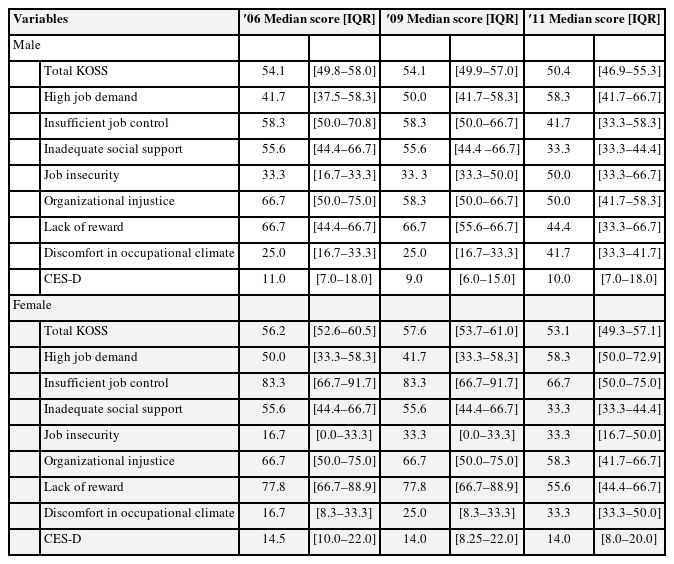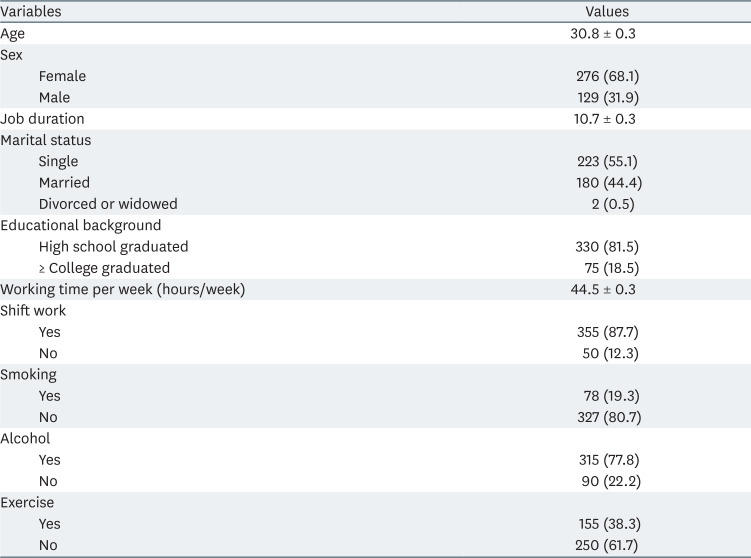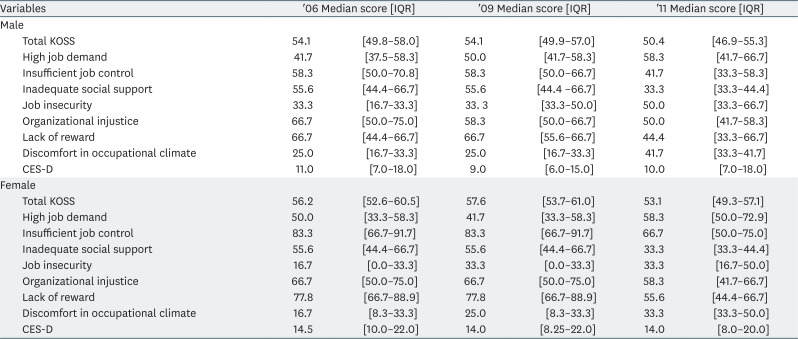Longitudinal associations between occupational stress and depressive symptoms
Article information
Abstract
Background
Most of the studies that have examined the association between the sub-factors of occupational stress and depressive symptoms have used cross-sectional data. However, our study has longitudinally measured the occupational stress and depressive symptoms of Korean workers of a semiconductor manufacturing company across six years to intending to investigate the associations between the sub-factors of occupational stress and depressive symptoms using longitudinal data.
Methods
Data collected from the workers of a semiconductor manufacturing company. Out of 1,013 recruited workers, 405 (40.0%) completed the survey questionnaires at 3 and 6-year follow-ups. Occupational stress was measured using a shorter version of the Korean Occupational Stress Scale (KOSS), whereas depressive symptoms were assessed using the Korean version of the Center for Epidemiological Studies-Depressive Symptoms Scale (CES-D). The data of male and female participants independently analyzed. Longitudinal associations were analyzed using panel data analysis with fixed effects.
Results
In panel data analysis with fixed effects, job insecurity (B = 0.048, p-value = 0.004) was associated with depressive symptoms among male workers. In female workers, inadequate social support (B = 0.080, p-value < 0.001), job insecurity (B = 0.039, p-value = 0.004), lack of reward (B = 0.059, p-value = 0.004) and discomfort in occupational climate (B = 0.074, p-value < 0.001) were associated with depressive symptoms among female workers.
Conclusions
Temporal changes in the sub-factors of occupational stress were associated with changes in depressive symptoms within the same period. There was a gender difference in occupational stress sub-factors related to depressive symptoms.
BACKGROUND
Occupational stress can cause workers to experience depressive symptoms [1]. Although stress can be perceived as a challenging situation that can potentially lead to positive outcomes [2], it also is more known to cause physical, psychological and social problems [3]. Past studies have shown that excessive occupational stress is significantly associated with depressive symptoms [34]. For example, studies that have been conducted among nurses in Korea and Japan have found that there is an association between occupational stress and depressive symptoms [56].
Several previous studies have shown that the various sub-factors of occupational stress, such as difficult physical environment, high job demands, insufficient job control, inadequate social support, job insecurity, organizational injustice, a lack of rewards, and discomfort in occupational climate can result in depressive symptoms [478]. Most of the studies that have examined the relationship between occupational stress and depressive symptoms have used cross-sectional data. Although some studies have used longitudinal data, a majority of them have not examined a variety of occupational stressors [89]. Recently, studies trying to confirm the relationship between various occupational stress and depression are ongoing [1011]. In the prior longitudinal studies' results suggest a link between occupational stress and depressive symptoms. However, some of these studies various occupations grouped into only a few categories to analyze; it did not reflect the change of occupational stress over time in a single occupation [891011]. In particular, no prospective cohort study was found between occupational stress and depressive symptoms among Korean workers. Therefore, we tried to use homogeneous samples recruited from the same workplace to identify Korean worker's occupational stress effects.
In our study, we examined the occupational stress and depressive symptoms of workers of a semiconductor manufacturing company across 6 years, to analyze the relationship between the sub-factors of occupational stress and depressive symptoms.
METHODS
Study participants
Data collected from the workers of a semiconductor manufacturing company. Out of 1,013 workers, 405 (40.0%) completed the questionnaires at 3- and 6-year follow-ups. Of the 405 workers who completed the survey, 129 were men, and 276 were women. We surveyed the workers thrice (i.e., in 2006, 2009, and 2011). Only the data of workers who participated in all the three surveys analyzed.
Occupational stress
To measure occupational stress, we used a shorter version of the Korean Occupational Stress Scale (KOSS) [12]. Specifically, a 24-item shorter version of the 43-item KOSS used to collect data. It assessed the following seven sub-factors; high job demands, insufficient job control, inadequate social support, job insecurity, organizational injustice, a lack of rewards, and discomfort in occupational climate. Subscale scores can be converted and represented within a 100-point scale. The Cronbach’s alpha coefficients of the different sub-factors ranged from 0.72 to 0.86 in this study.
Depressive symptoms
To measure depressive symptoms, we used the Korean version of the Center for Epidemiological Studies-Depressive Symptoms Scale (CES-D) [1314]. Depressive symptoms that the respondents had experienced during the past week were assessed using 20 items; Responses were recorded on a scale that ranged from 0 to 3, and total scores could range from 0 to 60 [13]. The Cronbach's alpha coefficient of this scale was 0.95 in this study.
Statistical analysis
The analyses conducted using STATA version 16.0 (Stata Corp, Texas Station, TX, USA) was used. Each subscale score of the KOSS was converted and situated within a 100-point scale. The total score on the KOSS calculated as the average of seven subscales scores. The conversion equation was as follows;
We first conducted a multiple linear regression analysis to identify the cross-sectional correlation between occupational stress sub-factors and depressive symptoms. Multiple linear regression analyses conducted using 2009 data. The reason for using the 2009 data is that most of the confounding factors investigated in 2009.
We used panel data analysis with fixed effects to identify the relationship between the change of occupational stress sub-factors and the change of depressive symptoms over time.
RESULTS
Sample characteristics
Out of 1,013 workers of a semiconductor manufacturing company who were invited to participate in this study, 405 (40.0%) completed the questionnaires across all three waves of the study. Their mean age was 30.8 ± 0.3 years in 2009. Of the 405 participating workers, 276 (68.1%) were women and 129 (31.9%) were men. Their mean job tenure was 10.7 ± 0.3 years in 2009 (Table 1).
The CES-D and KOSS scores
The distributions of the CES-D and KOSS scores present in Table 2. The median CES-D score of female workers was higher than that of male workers in 2006, 2009 and 2011, and also the median total score on the KOSS was higher in female workers.
Seven sub-factors of occupational stress assessed; high job demands, insufficient job control, inadequate social support, job insecurity, organizational injustice, a lack of rewards, and discomfort in occupational climate.
Cross-sectional and longitudinal associations between occupational stress and depressive symptoms
In a multiple linear regression analysis using the 2009 data to identify cross-sectional relationships between occupational stress and depressive symptoms, high job demand (B = 2.26, p-value = 0.026) was strongly associated with depressive symptoms among male workers (Table 3). Among female workers inadequate social support (B = 2.30, p-value = 0.022), job insecurity (B = 2.75, p-value = 0.006), and discomfort in occupational climate (B = 5.45, p-value < 0.001) were strongly associated with depressive symptoms, when confounding factors were adjusted.
In panel data analysis with fixed effects to identify longitudinal associations between occupational stress and depressive symptoms, the change in job insecurity (B = 0.048, p-value = 0.004) significantly correlated with the change in depressive symptoms among male workers (Table 3). In female workers, there was a significant association with depressive symptoms in inadequate social support (B = 0.080, p-value < 0.001), job insecurity (B = 0.039, p-value = 0.004), lack of rewards (B = 0.059, p-value = 0.004), and discomfort in occupational climate (B = 0.074, p-value < 0.001).
DISCUSSION
Our study examined longitudinal relationships between changes in the sub-factors of occupational stress and depressive symptoms among workers of a semiconductor manufacturing company. In our study, we examined how changes in the sub-factors of occupational stress correlated with changes in depressive symptoms. Each sub-factor represents a specific occupational stressor. The results of our study showed changes in the sub-factors of occupational stress could affect change in depressive symptoms.
Potential confounds, namely, age, sex, marital and smoking status, alcohol consumption, engagement in exercise, job tenure, shift work and working hours per week, were identified from the existing cross-sectional studies [15161718]. Our study presented the results of a cross-sectional study that adjusted various potential confounds. We compared the results of the panel data analysis with fixed effects and existing cross-sectional studies.
Because there is a gender difference in occupational stress and depression [1219], we stratified gender. Among men, there was a positive relationship between changes in job insecurity of occupational stress and depressive symptoms. This is different from the cross-sectional results of our study. And in another cross-sectional study, four sub-factors of occupational stress, namely such as job demands, inadequate social support, a lack of rewards, and discomfort in occupational climate were associated with depressive symptoms among male workers [20]. This cross-sectional study result implicates that it can be changed depending on where male workers work; different individual occupational stressors may affect depressive symptoms in the individual workplace. Besides, even though a worker works a long duration in one workplace, our follow-up study suggests that changes in a sub-factor of the occupational stress can affect change in depressive symptoms over time. This semiconductor manufacturing company restructured at the end of 2019 due to the economic crisis, so male workers may have experienced significant job insecurity.
Among women, changes in four sub-factors of occupational stress, namely, inadequate social support, job insecurity, lack of reward, and discomfort in occupational climate were associated with changes in depressive symptoms. These results are similar to our cross-sectional results. It is also in line with the previous study that emphasizes the importance of social support in women workers [21]. This implicates that female workers have more various occupational sub-factors associated with depressive symptoms than male workers, even in the longitudinal study.
The results of our study's panel data analysis with fixed effects indicate that changes in the sub-factors of occupational stress of an individual over time can influence the score of the individual's depressive symptom scale. According to the panel data analysis with fixed effects model results of our study, when the job insecurity score increased by one, male workers' depressive symptoms scores increased by 4.8%, and female workers' scores increased by 3.9%. In female workers, in particular, inadequate social support, discomfort in occupational climate, and lack of reward showed a greater effect of 8.0%, 7.4%, and 5.9% respectively. However, care must be taken in interpreting the change of score in the CES-D score. Changes in scores on CES-D do not necessarily mean that depression occurs. This is the reason for using cutting points in the CES-D score interpretation. Nevertheless, we can infer that there is a positive correlation between changes in occupational stress and depressive symptoms over time within an individual because higher scores on the CES-D indicate a higher degree of depressive symptoms [22].
In our study, gender differences in results of the association between changes in occupational stress sub-factors and depressive symptoms can be not only because of the biological difference between men and women but also by occupational factors. The female workers, who participated in this study tended to be younger, work experience shorter, involved in the production, and shift workers. Immature work skills because of short work experience and irregular work schedules can make you more vulnerable to negative relationships with coworkers. Some studies of nurses have shown that less experienced nurses are more easily affected by social support for depressive symptoms than career nurses [2324]. Our study results indicate that women workers are more influenced by social support for depressive symptoms because of differences in working conditions as well as biological sexual differences.
This study is unique because it longitudinally examined the occupational stress and depressive symptoms of workers of a manufacturing company thrice across a span of 6 years. The changes in depressive symptoms were significantly associated with changes in occupational stress over a relatively long period. The use of a longitudinal design in this study was advantageous because it allowed us to investigate individual changes in both occupational stress and depressive symptoms across a timespan. It is also important to note that this was a long-term follow-up study. Our study results could serve as epidemiological evidence of the temporal association that exists between occupational stress and depressive symptoms among workers.
Although the present study makes important contributions to the literature, it has several methodological limitations. To examine the relationship between occupational stress and depressive symptoms, there is a risk of overestimating the relevance because the assessment tools used the total score rather than the cut-off point. Also, high turnover rates are a characteristic feature of the semiconductor manufacturing industry; our result is a limitation to generalization with a 40.0% follow-up rate.
We did not examine temporal changes in confounding factors. Most of the covariates measured in 2009, but not across the other times of data collection. In most cases, there is likely to have been no temporal change, but changes in status such as divorce can have a significant impact on depressive symptoms. The impact of these confounds may have therefore been underestimated in the present study.
CONCLUSIONS
Our study examined the longitudinal associations between occupational stress and depressive symptoms. Temporal changes in the sub-factors of occupational stress were associated with changes in depressive symptoms within the same period among Korean workers. There was a gender difference in occupational stress sub-factors related to depressive symptoms.
Notes
Competing interests: The authors declare that they have no competing interests.
Availability of data and materials: Please contact the author for data requests.
Author Contributions:
Conceptualization: Kim HD, Park SG.
Formal analysis: Kim HD, Park SG.
Investigation: Kim HD, Park SG.
Supervision: Kim HC, Leem JH.
Writing - original draft: Kim HD.
Writing - review & editing: Park SG, Won Y, Ju H, Jang SW, Choi G, Jang HS, Kim HC, Leem JH.
Abbreviations
CES-D
Korean version of the Center for Epidemiological Studies-Depressive symptoms Scale
IQR
interquartile range
KOSS
Korean Occupational Stress Scale






